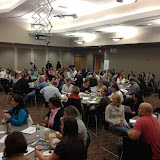English Department Meeting
February 1, 2012:
Revision of Reflection Rubric
Process for piloting the reflection rubric:
At the January department meeting, members of the English department were charged with piloting the reflection rubric developed in a NEASC group. Teachers paired with another member of the department in order to debrief their findings before we met in February. We had approximately one month to design, implement and gather student feedback about the clarity and purpose of the reflection task and rubric. Approximately 600 students from thirty sections of classes ranging from freshmen to seniors participated in the pilot.
Reporting from teachers:
Hannah and Jim:
Hannah’s classes did a mid-year reflection on writing goals. She asked if the goal was achievable, did you reflect successfully on your own learning.
Insights from data:
Student reflections were not specific, and therefore students need to learn to reflect.
Students were confused on the meaning of the last two boxes on the rubric in which they were asked to reflect on the reflection.
Jim’s students were asked to reflect on the midyear exam as well. They were asked to reflect on the mid-year exam and articulate their strengths and weaknesses. He asked how they progressed from their last reflection.
Insights from data:
Students echoed the first reflection.
Kat and Aaron:
Kat’s junior classes reflected on the research process having completed the research paper.
Insights from data:
Do reflections sooner, frequently during the research process so students can modify their goals along the way.
The paradigm of ‘with minimal guidance” or “independently…” was hard to grade.
Aaron:
Seniors used the course reflection journals to evaluate their progress in the class.
Insights from data:
Students could evaluate progress because it was a regular part of the class.
At this point in the meeting, the discussion opened up to all members. Teachers began to focus on themes regarding student reflection. Here are some of the insights from that discussion.
· We need to teach students how to reflect. Reflections over time will increase student investment
· How do we teach them to reflect? Set goals at the beginning of the year or quarter. Knowing you will need to reflect, knowing that you will look at skills closely on a regular basis to understand how you have grown will help students increase capacity to reflect
· Reflection helps students be accountable for their learning. Students whether they are upper classmen or in honors does not guarantee that they know how to reflect
· Students need to take into account teacher and peer feedback when reflecting
· Important to reflect after formative assessment
· Concern about the current scale used on the NEASC rubrics because so many boxes fall below goal; need to understand the reasoning behind this
Proposals for the revision of the reflection rubric, based on student feedback and teacher observation:
1. Provide a brief context for the rubric by distinguishing between the two types of reflection it will assess.
2. Reorder dimensions of performance to mirror the logical sequence of reflection
- Gathering and evaluation of materials
- Drawing conclusions from those materials
- Setting goals based on those conclusions
3. A subcommittee of English department members will move forward and apply synthesized student and teacher feedback to the rubric before bringing it to the faculty.
Post-Meeting Discussion
The reflection rubric plays the role of supporting skill-specific expectations in subject areas; in and of itself, the rubric is a cross-disciplinary measure for the reflective habits of mind that serve as a schoolwide 21st century learning expectation.
Within a discipline, "Advanced" performance on reflection will tell the students and the teacher when it is time to develop more challenging expectations. Students may then seem to go backward in their reflection practice, when in reality they may be making the adjustment to a new set of expectations. The rubric should be designed with the a sense of increasingly challenging expectations in mind.
- In short, the purpose of the reflection rubric is to help students develop the skills/habits of mind to successfully deal with increasingly challenging expectations in their courses.













